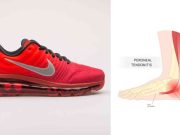Are you a runner looking for the perfect shoes? Do you find yourself wondering what “drop” means when shopping for running shoes? If so, then this blog post is for you! We’ll walk you through the basics of drop, as well as some tips on finding the right running shoe with the right drop. In this article, we will talk about “What does drop mean in running shoes“.
Table of Contents
What is Heel Drop?
Heel drop, or pitch, is the difference in height between the heel and forefoot of a shoe. It’s measured in millimeters, and traditional running shoes will typically have a heel drop of about 10mm or more. This offers runners lots of cushioning in the heel, which can help promote landing on the heel first. Heel drop affects your running style and can be beneficial for some runners, while others may prefer lower drops or alternative options. Whether you’re a beginner runner or a professional athlete, it’s essential to consider how your chosen running shoe’s heel drop will affect your performance and comfort levels.
What Does Heel Drop Mean for Runners?
Heel drop is an important factor for runners when looking for the best running shoes. The drop, or difference in height between the heel and forefoot, affects how the shoe feels when running and can provide either a cushioning effect or a more natural, barefoot-like feel. Low heel drops (0-4mm) offer a more natural running experience, allowing the foot to move more freely but with less cushioning. High heel drops (8-12mm) provide more cushioning and support but may not allow the foot to move as freely. It is essential to choose a shoe with the right heel drop that suits your individual needs.
How is Heel Drop Measured?
Heel drop is measured in millimeters, with 0 being the baseline for shoes with no drop. The difference in height between the heel and forefoot is then measured, with higher numbers indicating a steeper angle between your heel and toe. This measurement is essential, as it helps to determine the type of strike you’ll have when running—a midfoot or forefoot strike is more likely with lower heel drops, while higher heel drops encourage a heel-first strike. Depending on your running form and goals, you may find that a specific heel drop range is more beneficial to you than another.
What is the Ideal Heel Drop for Running Shoes?
The ideal heel drop for running shoes depends on the individual’s running style and preferences. Generally, a heel drop between 4 and 8 mm is considered to be the sweet spot for most runners. This drop provides enough cushioning for the heel strike while maintaining a more natural gait. For runners who land heel first and have issues with their Achilles tendon, a higher heel drop (over 7mm) is recommended to provide more support and shock absorption.
However, it’s important to note that there is no “one size fits all” solution for heel drop, so it’s important to try out different levels of cushioning to find what works best for you. Additionally, zero-drop shoes are becoming increasingly popular for those looking for a more minimalist approach.
What are the Pros and Cons of Low Heel Drops?
When considering the pros and cons of low heel drops, it’s essential to understand what it means. Low-heel drops are shoes with a heel part at the same level or less than 8 mm as the ball part of the shoe. This type of shoe allows for a midfoot or forefoot strike, a low-impact running gait that many runners prefer.
The reduced impact can benefit those who are more prone to injury and those who are looking to improve their times. However, lower heel drops may not be ideal for runners with existing biomechanical issues, as they can cause further strain on the foot and ankle. Ultimately, it’s crucial to find the right balance between heel drop and cushioning when selecting running shoes to get the most out of your runs.
What are the Pros and Cons of High Heel Drops?
High heel drops can provide more cushioning for runners and can help absorb the impact from initial contact with the ground, which can be beneficial for those with a higher BMI or those who may be prone to injury.
However, these shoes are generally heavier and can cause instability on uneven terrain. Additionally, they may limit arch and ankle articulation, which can decrease overall agility and interfere with the natural running motion. Ultimately, it’s important to consider how your running style and goals match with the appropriate heel drop for your shoes.
What are Zero Drop Shoes?
You may have heard about zero-drop shoes and wondered what they are. Zero-drop shoes are shoes with no difference in height between the heel and the toe. This means that your heel and forefoot are at the same distance from the ground, eliminating any extra cushioning or drop in the shoe’s sole.
This type of shoe encourages a more natural running style and can help you to improve your overall running performance. The lack of cushioning or extra drop also helps to promote a more even weight distribution across your entire foot, helping to reduce fatigue and improve your balance. While zero-drop shoes can be beneficial for some runners, it is essential to consider whether they are suitable for you, depending on your specific needs and preferences.
Are There Any Alternatives to Heel Drop?
When it comes to running shoes, heel drop is the most common measure of cushioning. However, there are alternatives to this traditional method. For instance, some manufacturers have begun using midsole technology such as EVA foam, polyurethane foam, or a combination of both to provide cushioning. These materials are designed to absorb more shock and reduce the amount of impact on the joints. Additionally, some brands have developed unique suspension systems that provide extra cushioning and stability for runners. Ultimately, the choice of shoe cushioning is up to the individual runner and their unique needs.
How to Choose the Right Running Shoes for You?
Choosing the right running shoes can be a daunting task, but understanding heel drop can help you make an informed decision. Start by considering your running goals, gait type, and the type of terrain you’ll be running on. Heel drop is measured in millimeters and ranges from 0 to over 20mm.
A lower heel drop offers more stability and cushioning for long-distance runners or those running on flat surfaces. Higher heel drops can provide more cushioning and shock absorption for those running on rougher terrain or short-distance sprints. Zero-drop shoes are another option that may help improve posture, but they take time to adjust to if you’re not used to them. Ultimately, the right shoe for you will depend on your individual needs and preferences, so consider all of your options before making a decision.
What heel drop is right for me?
Choosing the right heel drop for you is an important decision that will affect your running performance. As we discussed earlier, heel drop is measured in millimeters and can range from 0 to 20mm. Generally speaking, runners who prefer a more natural running experience—such as those who practice barefoot running—tend to prefer a 0mm or low-heel drop shoe.
On the other hand, those looking for more cushioning and support may prefer a higher heel drop. Ultimately, it’s up to you to decide what heel drop works best for you and your running style. To determine the ideal heel drop for you, consider your feet, legs, and overall running form. You can also try out different options with your favorite pair of running shoes to see which one feels the most comfortable and natural for you.
In conclusion, the drop of your running shoes is an essential factor to consider when purchasing running shoes. Heel drop, or the difference in midsole height between the heel and forefoot, can significantly impact your running performance. Low and minimalistic heel drops can lead to a quicker stride rate, resulting in a better running economy.
However, high heel drops can provide more cushioning and protection for your feet. The ideal heel drop for your running shoes will depend on many factors, such as your speed, foot strike pattern, history of injury, and preference. Therefore, it is crucial to choose the right running shoes that will provide you with the best cushioning and support for your feet.
































